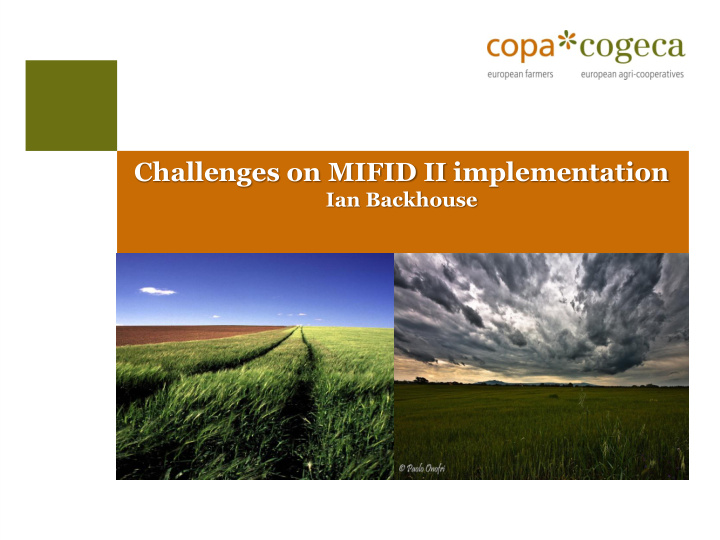



Challenges on MIFID II implementation Ian Backhouse
What about the grain sector ? • representing more than 1 million farm in EU 28; • as well as around 12 000 agri-cooperatives • competing on the world market with export capacity growing during the next decade; • Facing more and more weather risk with less PPPs; 09.11.2016 Ian Backhouse – Mifid Implementation | 2
Market share of agri-ccops in cereals - cooperatives collect: - 74% of cereals produced in France; - 50% in Germany; - 28% in Italy, - 35% in Spain, - 12% in Hungary, - 7% in Poland... - There is a more of Primary (57%) than secondary cooperatives (agri-food activities); - There is a growing number of transnational cooperatives (they contract with farmers, buy their products or sell them inputs , they have a membership relationship with those supplying or purchasing farmers in various MS). 09.11.2016 Ian Backhouse – Mifid Implementation | 3
Grain sector challenges in EU • The eastern EU will be the main area of growth due to yield and export potential, offering opportunities for large global players and western European collectors wanting to diversify sourcing options • France and Germany are the two engines in EU G&O production , and they are expected to see growth in mainly ’inland origination’. Players with pan - European ambitions should increase sourcing opportunities in eastern EU, presence in destination and strengthening of inland origination in their home countries . • In the southern EU, we expect rationalisation of both inland and port infrastructure . While key traders continue to benefit from the net import position of these countries, local cooperatives can gain a bigger role by learning from business models in the north western EU 09.11.2016 Ian Backhouse – Mifid Implementation | 4
How Do Farmers Sell On the whole Farmers are Simple Souls!!! - Most do not use Exchange Traded Derivatives at all!! - Most use physical contracts with varying degrees of complexity. Some with underlying risk management. - Some use tools provided by trade partners, such as options , but will be OTC . 09.11.2016 Ian Backhouse – Mifid Implementation | 5
How Do Farmers Sell Spot Cash Sale on the day through traders for short term delivery. Direct long term supply contract with an end user. Collectively Utilising collective sales: cooperatives or Pool arrangements with private traders Forward Forward contracts entered into with traders with or without first processor contract 09.11.2016 Ian Backhouse – Mifid Implementation | 6
Regulatory Technical Standards (RTS) – Hedging definition RTS on ancillary activity exemption defines hedging, based on the EMIR (OTC) guidance document but : - Specific characteristics of agri-commodity markets (many geographies, products, suppliers, time horizons, etc.) require complex risk management systems, e.g. macro portfolio hedging, - The farmers and coops, are using various Risk management methods, depending on the risks, the tools they used, their business approach. We hope that the approach selected could take into account all the legitimate methods and practices actually considered “hedging” by the industry. 09.11.2016 Ian Backhouse – Mifid Implementation | 7
MIFID and Ag sector Questions being raised, even with the knowledge we have: - Should we as growers apply for a Hedging Exemption automatically. For all situations. - How will the relationship between the Hedging Exemption and OTC contracts work. - Will we find our trade partners Agri-Coops and Merchants have to remove many of the contracts they have devised to manage our risk. 09.11.2016 Ian Backhouse – Mifid Implementation | 8
MIFID and Ag sector - Forward contracts must not be caught within scope of MiFID II as 50% of contract are based on formula which include future market; - The complexity and cost of compliance with the new regulation must not be such that access to price risk management tools is no longer directly available to individual farming businesses (which are usually SMEs) - Compliance costs: include annual and individual trades interaction with National Competent Authorities, directly and via brokers (who will charge fees for transactions), the cost of audit (maybe via accountants) to prove status as legitimate entity to claim hedging exemption, position limit exemptions… 09.11.2016 Ian Backhouse – Mifid Implementation | 9
Mifid and Ag. sector - The risk that these regulations will destroy liquidity on already fragile markets and prevent emergence of new venues and contract relevant to the needs for farmers (fertilisers, other inputs, dairy, sugar…) Modern Technology has allowed for an explosion in price discovery, market commentary and deeper information. There is greater transparency for the farmer but: This requires markets that are Liquid. 09.11.2016 Ian Backhouse – Mifid Implementation | 10
Mifid and Ag. sector - If the rules are not sufficiently accommodating to the needs of farmers, the up to date mechanisms for market management will escalate to a massive increase pressure public intervention, set-aside and export support; 09.11.2016 Ian Backhouse – Mifid Implementation | 11
Thank you! www.copa-cogeca.eu @CopaCogecaCropS Copa-Cogeca | The voice of European farmers and their cooperatives | 12
Recommend
More recommend